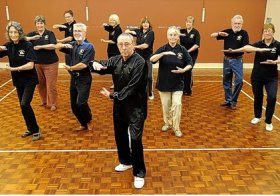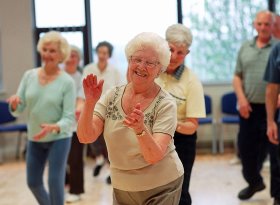Exercises for stronger bones
What do you think will happen to a house if its framework is weak and rickety? Right, it will soon collapse.
Well, if we don’t take care of our bones which are the support system of our body, then our body too could “collapse”.
That is, we could develop osteoporosis (literal meaning: porous bones), a bone disease that makes us prone to falls and bone fractures. Osteoporosis makes our bones so weak, they could break after even a minor fall or slight injury.
When we’re younger, most of us tend to worry about suffering from heart disease or cancer or maybe even dementia later on, while osteoporosis and bone fractures are not given the attention they deserve. Just imagine. Even one bone fracture could drastically change an older person’s life. Just one fracture could result in immobility and permanent dependence on others.
The bad part is that, according to the International Osteoporosis Foundation, roughly one out of every three women, and one out of every five men could develop osteoporosis after crossing fifty and be prone to bone fractures. Also, since this disease progresses silently, it could go undetected till a bone fracture occurs. But the good part is, osteoporosis can be prevented from getting worse and even reversed to some extent.
The reason our bones become weaker with age is that as we grow older, our body loses more bone tissue than it can make. We will not be able to entirely replace all the lost bone tissue, but we can certainly maximise bone building and minimise bone loss, and thus reduce the risk of bone fractures. We can achieve this through: 1) exercise; and 2) the right nutrition (which we’ll look at in another blog post).
Actually, exercise is a sort of miracle cure that offers a whole lot of health benefits besides preventing bone fractures. So first, let’s look at what these are.
Why you should exercise
- To strengthen your bones, tone your muscles, and stay healthier
- To maintain a better quality of life even in your old age
- To stay independent longer and reduce the chances of having to rely on others even for simple things
- To stay flexible and energetic enough to do the things you enjoy even in the senior years
- To avoid depression and maintain a zest for life
Senior exercises for preventing bone fractures
Being as active as possible is a great way of making our bones stronger. So, avoid a sedentary lifestyle and instead try to find physical activities you could enjoy. Attend to tasks in the kitchen or garden, go grocery shopping, go for walks, go birdwatching, climb stairs if you can… and engage in a regular exercise program. Experts say even 30 minutes of some form of exercise, preferably daily, could improve our bone health.
There are three types of exercises for building stronger bones:
Resistance or weight-bearing exercises
Such exercises are of two types: a) activities during which supporting your own body weight puts some strain on your bones – like brisk walking, jogging, running, dancing, climbing stairs, playing sports like table tennis, and hiking; and b) strength training that involves the use of weights or resistance bands.
Resistance and weight-bearing exercises also tug at the muscles attached to bones. As a result, both muscles and bones adapt to the stress by building more muscle or bone cells and thus become stronger.
Stronger bones won’t fracture easily. And more toned muscles will reduce the risk of falling and make sure you react more quickly in case you do lose your balance and fall. Stronger muscles also make it easier for the elderly to be more active, and to get out of bed or from a chair by themselves.
Exercises for balance
 These exercises improve muscle strength, posture, and balance, and are specially useful for lowering the risk of falls and broken bones.
These exercises improve muscle strength, posture, and balance, and are specially useful for lowering the risk of falls and broken bones.
Simple senior exercises you could do at home include practising standing on one foot, then on the other. Begin by holding on to a chair as you do this, then try it without anything for support.
Dancing, Tai Chi, and specific yoga exercises too have been proved to improve balance and strengthen muscles.
Exercises for flexibility
 These exercises involve the stretching of muscles. Practising these would make it easier for you to reach up for anything, pick up something from the floor, or look over your shoulder. They are also useful for reducing back pain, keeping your spine supple and correcting your posture.
These exercises involve the stretching of muscles. Practising these would make it easier for you to reach up for anything, pick up something from the floor, or look over your shoulder. They are also useful for reducing back pain, keeping your spine supple and correcting your posture.
Simple stretching exercises you could do to loosen and lengthen tight muscles and thus improve flexibility include: arching your back and bending backwards; raising your knees; rotating your shoulders and wrists; wriggling your toes; sitting on the floor with your legs stretched out and moving your feet at the ankles towards your body and then away from it; and laying down on your back and pulling your knees towards your chest.
Dancing, Tai Chi, and yoga are also good for enhancing the flexibility of your body and joints. Just remember stretching movements need to be done slowly and not to the extent that they cause pain. The idea is to loosen up your stiff body, not kill yourself.
What you should avoid
Most spine fractures occur while bending forwards too much. So avoid exercises that involve such movements or sharp rotating of the trunk, as in some yoga exercises. If you need to pick something off the floor, don’t bend from the waist down, but bend your knees and lower your hips towards the floor instead.
Useful sources for checking out exercises for preventing bone fractures
Think you’re too old to exercise on your feet? Well, you can sit and still be fit. These chair exercises will show you how:
And how about jazzing things up a bit with these low-impact dance moves? No matter if you have two left feet, here’s how you could sway those hips and shake a leg to keep your bones strong and healthy:
A few more sources:
A medley of warm-up, cardio, and aerobic weight-bearing exercises:
http://www.youtube.com/watch?v=8EwvYmcmrTY
For those looking for a more relaxed pace while exercising, check out this great 8-minute Tai Chi workout:
http://www.youtube.com/watch?v=PNtWqDxwwMg
10 posture exercises:
http://www.youtube.com/watch?v=WJspJaFL_l8
A simple heel raise for exercising your calf muscles and ankles and lowering the risk of falling:
http://www.youtube.com/watch?v=Vg85PkpxBYk
According to medical professionals, you could get even better results by gradually increasing the intensity of your exercise routine – either increasing the pace, the weights, or your working out time. Also, exercises with weights or resistance bands have to be done around twice or thrice a week, and the other types (weight-bearing, balance, and flexibility) five times a week if not daily.
A word of caution. Some of the exercises may not be suitable for you. So before starting any exercise program, consult your doctor, specially if you already have osteoporosis or have had a bone fracture.
Finally, no matter how old you are, 60, 70, or 80, remember no age number is too high to start some sort of regular physical activity.
So just get moving!
